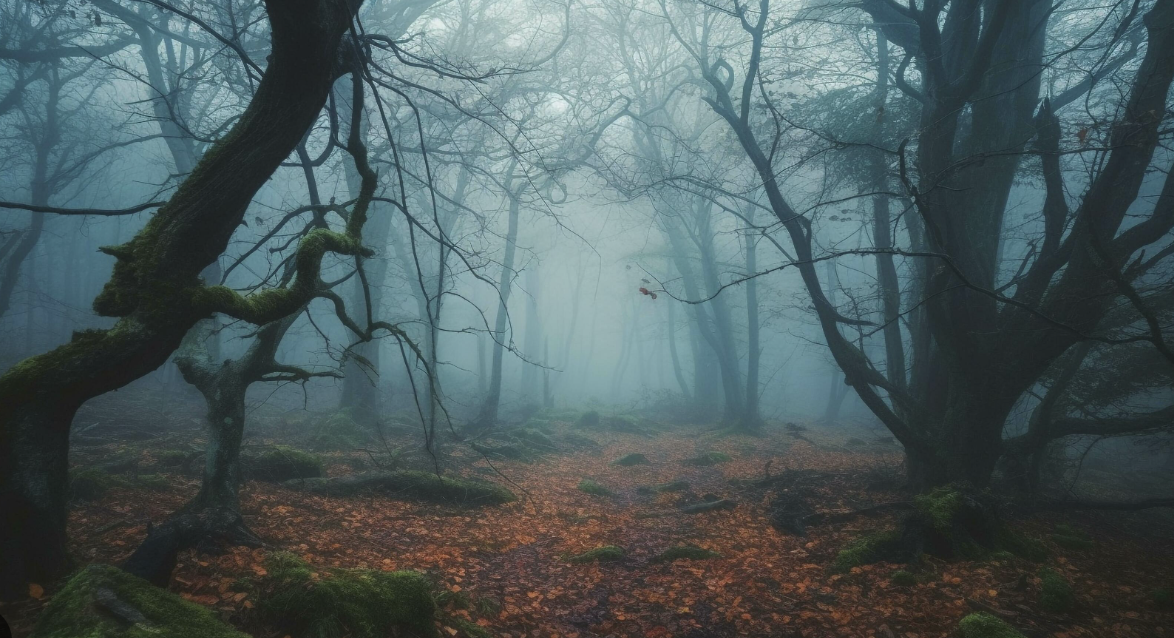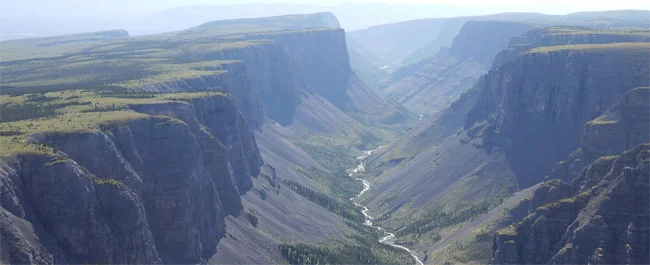
Mysterious Stories Blog
Strange, disturbing and mysterious stories from the outdoors
Mysteries of the Nahinni Park Reserve in Canada
Revised May 2024
Nahanni National Park Reserve in the Dehcho Region of the Northwest Territories, Canada, is around 300 miles west of Yellowknife and is 11,000 square miles in area. Part of the Mackenzie Mountains resides within it and the South Nahanni River (Naha Dehé) is at its centre. It was named a national park in 1976, and a UNESCO World Heritage Site in 1978.
The park is surrounded by huge peaks and features geysers, sinkholes, deep canyons, caves, gorges, and beautiful, untouched forests. Within these stunning vistas lies Virginia Falls, a 315-foot (96-meter) high waterfall twice as high as Niagara Falls.
The area is a true wilderness and has been largely unexplored as it is accessible only by air, water or a long overland journey by food over several days.
Nahanni is derived from the language of the indigenous Dene people who have inhabited the region for thousands of years. It means “The People Over There,” in reference to a tribe of mountain-dwelling people known as the Naha. The Naha were once known to raid lowland settlements before mysteriously vanishing. There is speculation that they may have been the ancestors of the modern-day Navajo people.
Over the years there have been many mysterious stories that have emerged from the area. The names of park areas such as Deadmen Valley, Headless Creek, Headless Range and the Funeral Range, relate to these stories and legends
The Valley of the Headless Men, the McLeod Brothers and the Lost McLeod Mine
Through oral history, the First Nation people speak of an unknown evil lurking within the spectacular 200-mile Gorge, also called the "Valley of the Headless Men," and most avoid the area. The name comes from a series of unexplained incidents in the Gorge during the Gold Rush of the early 20th century.
Two brothers, Willie and Frank McLeod left in 1906 in an attempt to reach the Klondike in the Yukon through Nahanni. Nothing was heard from them for the next two years, but there were rumours of them finding a gigantic gold mine. Since then the Lost McLeod Mine has become legendary, and many have lost their lives trying to find it in the park.
In 1908, another gold prospecting expedition found two bodies tied to a tree, later identified as the McLeod brothers, both of which had been decapitated. The brothers were found by Charlie McLeod, another brother, and he buried the headless men, planting a cross to mark their graves. There were seven witnesses when the grave was dug, all members of the search party.
Before their murders, a few trappers and hunters in the area say they saw a third man with the McLeods. Whether it was the third man who cut the heads off of the McLeods is unknown. There was speculation claim that the mysterious third man was seen trading gold at several Hudson Bay trading posts.
The McLeods first started prospecting in 1904, through British Columbia and parts of Southeast Alaska. Upon arrival in the Nahanni country, they ended up on the upper Flat River where they found Dogrib Indians with coarse gold nuggets, some as large as a quarter ounce in size. They made camp in the spring in the area where they were told the gold came from. The McLeods named the stream Gold Creek. The Indians apparently were not happy with their arrival. According to conversations with the McLeods, they said the Indians had probably taken the best finds. The prospect was a small one and the brothers used some small Indian-made sluices to aid in the extraction of any gold that was left. They were able to fill a toothache remedy bottle and had ten ounces of gold in a moosehide bag.
They took the sluices, which were made of hand-hewed or whipsawed local timber, and made a crude box-size boat to paddle down the Nahanni. They were about twenty miles down the river near the Cascades of the Thirteen Drops, which later was renamed, the Flat River Canyon. At this point they would have to travel about 110 miles down the Flat River, then eighty miles up the Liard River.
They started out through the canyon, but water entered the boat and they lost everything except the ten-ounce bag of gold and had to return to Gold Creek. They built another boat out of sluice box planks and a trackline from thin strips of moosehide so they could lower their possessions down the worst places in the river. Finally, they were able to make it down the canyon and up the Liard to Fort Liard.
Willie decided to work awhile for the Hudson Bay Company at the Fort, but in 1905 decided to head out in search of more gold. The McLeod’s gold camp in Deadman’s Valley was located in the spruce trees on the left bank of the Nahanni, not far below Second Canyon Mountain. One of the McLeods was in the habit of writing messages on trees. A message was found written on a broken dog sled runner that read: “We have found a fine prospect.”
The supposed third man in the party showed up at Telegraph Creek in British Columbia sometime later. The Mounted Police tracked him down and eventually traced him to Vancouver. It was estimated he had about $8,000 in gold nuggets.
The Lost McLeod Gold Mine has been the focus of countless searches. In 1963, the last group of gold prospectors in the area from Europe vanished without a trace.
More mysterious stories from Nahanni Park Reserve
In 1917, the decapitated body of a Swiss prospector, Martin Jorgenson, was found next to his burned cabin near Flat River. In 1945, the unnamed body of a miner from Ontario was found in his sleeping bag, without its head. Trapper John O'Brien was found frozen next to his campfire, matches still in his hand.
In 1962, the pilot of a light aircraft miraculously survived a crash unscathed and set about building a camp a short distance from the place where the plane went down. He was so well equipped to survive, with food, fuel, shelter, and camp provisions from the aircraft's cargo that he was confident that rescue would come within a matter of days. So he waited and wrote about his experiences in his diary. Many times, he watched as searching aircraft flew overhead, but none saw him. He was only six miles as the crow flies from his destination, although he was probably unaware of his exact location. For around fifty days, he sat alone, waiting for rescue, and then he mysteriously disappeared as the diary entries stopped abruptly. Six months later, his plane was discovered by chance, followed by the camp and his diary. To this day no further trace of him has ever been found.
Through the years other camps were found with remnants of bones and scattered equipment. It was as if someone wanted the valley to himself. Some of the deaths were investigated and it was discovered the prospectors had developed scurvy and died
The deaths have been blamed on natives, grizzly bears, fights between prospectors, or supernatural causes. Attacks by the locals who lived in the valley are most likely, as they would not have taken kindly to white men trespassing on their land.
Albert Johnson - Mad Trapper of Rat River
But there is another explanation. About forty miles from Nahanni, a loner named Albert Johnson lived in a crude log cabin. Albert Johnson was a pseudonym and his true identity remains unknown. He too searched for the McLeods’ lost mine. Johnson later became notorious and became known as the “Mad Trapper of Rat River.”
In December 1931, one of the native trappers complained to the local RCMP detachment in Aklavik that someone was tampering with his traps, tripping them and hanging them on the trees. He identified Johnson as the likely culprit. On December 26, Constable Alfred King and Special Constable Joe Bernard, each of whom had considerable northern experience, trekked the 60 miles (97 km) to Johnson's cabin to ask him about the allegations. Seeing smoke coming from the chimney, they approached the hut to talk. Johnson refused to talk to them, however, seeming to not even notice them. King looked into the cabin window, at which point Johnson placed a sack across it. The two constables eventually decided to return to Aklavik and get a search warrant.
King and Bernard returned five days later with two other men. Johnson again refused to talk and eventually, King decided to enforce the warrant and force the door. As soon as he began, Johnson shot him through the wooden door. A brief firefight broke out, and the team managed to return the wounded King to Aklavik where he eventually recovered.
Johnson was finally cornered on Eagle River in the Northern Yukon Territory, near the border of the Northwest Territories.
The event became a media circus as Johnson eluded the Royal Canadian Mounted Police (RCMP) team sent to take him into custody, which ended after a 150 mi (240 km) foot chase lasting more than a month and a shootout in which Johnson was fatally wounded on the Eagle River, Yukon.
In his possession were found some gold teeth extracted from the mouths of prospectors found dead in the Headless Valley. It might be assumed that Johnson was involved in their deaths, a theory the Mounties put on file.
Exclusive articles for members of StrangeOutdoors that are not available elsewhere on the site.
See the latest See the latest Exclusive members-only articles on StrangeOutdoors.com
Read other stories from the Northwestern Territories
The strange deaths of David Horesay and Frederick Hardisty in the Northwest Territories
Sources
https://en.wikipedia.org/wiki/Nahanni_National_Park_Reserve
http://mysteriousuniverse.org/2014/10/the-mysterious-valley-of-the-headless-corpses/
https://www.unexplained-mysteries.com/forum/topic/243515-the-nahanni-river-mystery/
https://buildfutureenergy.wordpress.com/2012/01/01/the-valley-of-headless-men-nahanni-canada-mystery-legend-hollowearth-hmmm-interesting/
http://raven-talesoftheweird.blogspot.ch/2011/02/valley-of-headless-men.html
https://www.icmj.com/magazine/article/the-lengendary-lost-gold-of-the-headless-valley-1541/
https://en.wikipedia.org/wiki/Albert_Johnson_(criminal)




